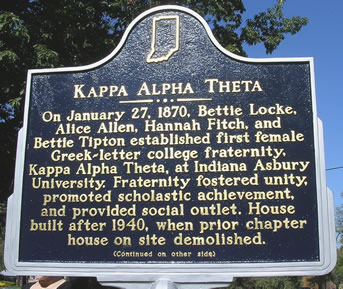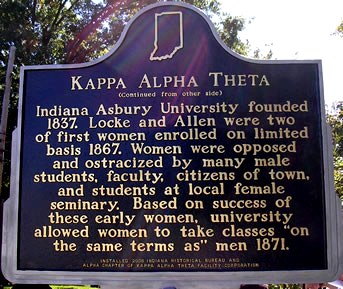

Location: 904 College Road, Greencastle. (Putnam County, Indiana)
Installed: 2006 Indiana Historical Bureau, Alpha Chapter of Kappa Alpha Theta Facility Corporation
ID# : 67.2006.1
Text
Side one:
On January 27, 1870, Bettie Locke, Alice Allen, Hannah Fitch, and Bettie Tipton established first female Greek-letter college fraternity, Kappa Alpha Theta, at Indiana Asbury University. Fraternity fostered unity, promoted scholastic achievement, and provided social outlet. House built after 1940, when prior chapter house on site demolished.
Side two:
Indiana Asbury University founded 1837. Locke and Allen were two of first women enrolled on limited basis 1867. Women were opposed and ostracized by many male students, faculty, citizens of town, and students at local female seminary. Based on success of these early women, university allowed women to take classes "on the same terms as" men 1871.
Keywords
Women, Education
Annotated Text
On January 27, 1870, Bettie Locke, Alice Allen, Hannah Fitch, and Bettie Tipton established first female Greek-letter college fraternity, Kappa Alpha Theta, at Indiana Asbury University.(1) Fraternity fostered unity, promoted scholastic achievement, and provided social outlet.(2) House built after 1940, when prior chapter house on site demolished.(3)
Indiana Asbury University founded 1837.(4) Locke and Allen were two of first women enrolled on limited basis 1867.(5) Women were opposed and ostracized by many male students, faculty, citizens of town, and students at local female seminary.(6) Based on success of these early women, university allowed women to take classes "on the same terms as" men 1871.(7)
(1)Lilian Hughes Neiswanger, "The First Coeds: An Account of the Dramatic Circumstances under which DePauw University Became a Coeducational Institution, 1867-71, " unpublished manuscript, DePauw University Archives, Greencastle, Indiana, 1935, http://www.depauw.edu/library/archives/articles/coeds1.htm (accessed June 14, 2005) (B00648); Estelle Riddle Dodge, Sixty Years in Kappa Alpha Theta (Menasha, Wis., 1930), 22-24 (B00640); Diana B. Turk, Bound by a Mighty Vow: Sisterhood and Women's Fraternities, 1870-1920 (New York, 2004), 18-20. (B00641)
The immediate impetus for the creation of the female fraternity was that Locke had been denied admission into a men's fraternity. According to Neiswanger:
It happened that Miss Bettie's brother, William Locke, was a "supporter" of the Phi Gamma Delta fraternity, called "Delt" at the time. . . It was the custom for feminine relatives or friends sometimes to send "refreshments" down to a fraternity meeting. Miss Bettie, upon occasion would prepare a basket of turkey-and all that would go with a turkey dinner-and send it down by William with her compliments to the Phi Gamma Deltas. One day, the appreciative fraternity sent word to her that the members should be very pleased if Miss Bettie would wear their fraternity pin, as a friend of the fraternity. . . Her reply was, "I shall be happy to wear the Phi Gamma Delta pin-if initiated into the fraternity. . . They may have known of no precedent to follow, although there are isolated cases of women being initiated into men's fraternities before and during this period. In the end, the force of tradition was too strong, and the Phi Gamma Delta compromised by sending Miss Bettie what everyone considered a very elegant silver cake basket instead of the fraternity pin.
Neiswanger, "The First Coeds." (B00648)
The original constitution for Kappa Alpha Theta is housed in the archives of the Kappa Alpha Theta Fraternity Headquarters, Indianapolis, Indiana.
The fraternity continued to grow in Indiana as chapters opened at several universities, including Indiana University and Purdue University. Over the next few years, chapters opened throughout the United States. Dodge, Sixty Years, 191-202. (B00640) Today there are 120 chapters throughout the United States and Canada, with over 170, 000 initiated members. Kappa Alpha Theta Web site at kappaalphatheta.org (accessed 6/20/05). (B00642)
(2) In particular the fraternity stressed composition, debate, elocution, and social etiquette. Neiswanger, "The First Coeds" (B00648) Neiswanger notes that the need for unity and for a social outlet were especially important because these "young ladies were entirely shut out of that intangible something which is college life. The third floor halls of the Literary Societies, the centers of extracurricular activities, were sacrosanct precincts, the men's last sanctuary." Neiswanger, "The First Coeds"(B00648); Turk, Bound by a Mighty Vow, 20-24, 30, 37, 39. (B00641)
(3)"Alpha Chapter House, " materials provided by Noraleen Young, August 30, 2005, copies with IHB. Photographs of earlier chapter houses posted on DePauw University's Web site, http://depauw.edu/library/archives/ehistory/chapter1/bettielocke.htm (accessed June 20, 2005). (B00673)
(4) While some of the sources from this era refer to the school as "Asbury University, " the name given in the law was "Indiana Asbury University." Laws of Indiana, 1836-1837, p. 9-13. (B00643)
Indiana Asbury University (DePauw University) was founded by the Methodist Episcopal Church.
(5) Other female students to be admitted in 1867 class were Amanda Beck, Laura Beswick, and Mary Simmons. Putnam Republican Banner, September 25, 1867; (B00654) "Freshman Class, " Annual Catalogue, 1868-69 (Indianapolis, 1868), p. 9-11; (B00653) George B. Manhart, DePauw Through the Years (Greencastle, 1962), 1: 80-81. (B00646)
Diana Turk contends that one of the primary reasons the school opened its doors to women was because the drop in enrollment during the civil war meant contributed to financial difficulties for the school. The board thus voted to allow women to enroll on a limited basis. Turk, Bound by a Mighty Vow, 16. (B00641)
Following is a list of early female schools opened in Greencastle:
1844-Harriet Dunn Larrabee's Greencastle Female Collegiate Seminary
1855-Asbury Female Institute
1861-Asbury Female Seminary
1866-Miss Grisby's Seminary
1879-Female College of Indiana
George B. Manhart, DePauw Through the Years (Greencastle, 1962), 1: 75-77; (B00646) First Annual Catalogue and Circular of the Female College of Indiana, Greencastle, Putnam County, Indiana, for the Year Ending Thursday, June 15, 1871 (Greencastle, 1871), 11. (B00657)
During this time there was an ongoing debate over the education of females. Many in society saw higher education as unfeminine and females as unable to meet the physical and mental demands of college. An example of this perspective is from The Reverend John Todd:
We want to put our daughters at school at six, and have their education completed at eighteen. A girl would feel mortified not to be through schooling by the time she reaches that age. In these years the poor things has her brain crowded with history, grammar, arithmetic, geography, natural history, chemistry, physiology, botany, astronomy, rhetoric, natural and moral philosophy, metaphysics, French, often German, Latin, perhaps Greek, reading spelling, committing poetry, writing compositions, drawing, painting, c., ad infinitum. Then out of school hours, from three to six hours of severe toil at the piano. She must be on the strain all the school hours, study in the evening till her eyes ache, her brain whirls, her spine yields and gives way, and she comes through the process of education enervated, feeble, without courage or vigor, elasticity or strength.
Rev. John Todd, "Women's Rights, " Votes for Women, 1848-1921, "The Learning Page, " Library of Congress, American Memory Web site at http://memory.loc.gov/learn/leassons/primary.html (accessed 7/19/05). (B00650)
(6)The Greencastle Banner published excerpts from Locke's commencement speech, entitled "Popular Prejudices." In the speech Lock describes her experiences and feelings regarding her time at Asbury. She remarks, '. . . she who seeks an education in one of these institutions [male colleges], must expect to pay a heavy tax on her privileges during the existing state of popular sentiment. The prejudice in the community against the attendance of girls in male colleges is to be encountered; the untiring opposition of many of the male students is to be met, for here, as elsewhere, 'Envy dogs success and every victor's crown is lined with thorns, and worn amid scoffs.' The ever present consciousness 'I am not welcome in this building;' the apprehension, 'When I come to receive my diploma, the alumni will scarcely recognize me as a sister alumna'-all this to be endured.' "Female Education, " Greencastle Banner, June 29, 1871, emphasis in original. (B00669)
As Lilian Hughes Neiswanger noted, "Everyone seemed against them, even their own sex. The hardest thing to bear in that bitter period, one of them said later, was the attitude of other girls of their own age. On the way home from classes, the college girls would meet the seminary ladies and be neatly snubbed by them. This snobbish ostracism by their former friends brought tears at night that no amount of antagonism from the young men could provoke." Neiswanger, "The First Coeds." (B00648)
(7)On June 21, 1871, a meeting of the Joint Board of Trustees and Visitors decided that "the admission of females to the regular classes" would be a measure of "both practicability and desirableness." The Board also adopted the recommendation of the faculty, to open "Preparatory classes to females on the same terms as the males." "Asbury University and Female Education, " Greencastle Banner, June 29, 1871. (B00675)
In 1867 women were admitted to Asbury on a limited basis. They could take regular college courses, or the "Classical Course." This was a four-year program that provided a general liberal education earning a Bachelor of Arts degree. "The Classical Course, is . . . a thorough, liberal education . . . The Bachelor of Arts is conferred upon those who satisfactorily complete this Course. The Scientific Course . . .covers four years, and embraces, besides scientific branches, two years in Latin, and also the German and French . . . The Degree of Bachelor of Science is conferred to those to satisfactorily complete this Course." Annual Catalogue of the Indiana Asbury University for 1867-68 (Indianapolis, 1868), 16-17. (B00677)
On the following day, June 22, Locke, Allen, Beswick and Simmons became the first females to graduate from Asbury. Annual Catalogue, 1871-72. (B00679)
